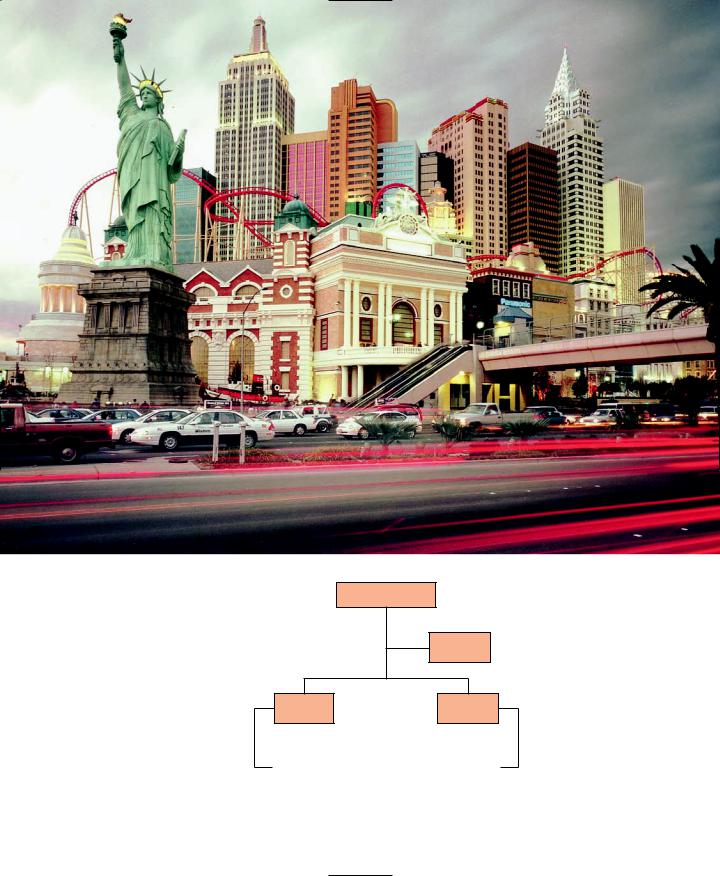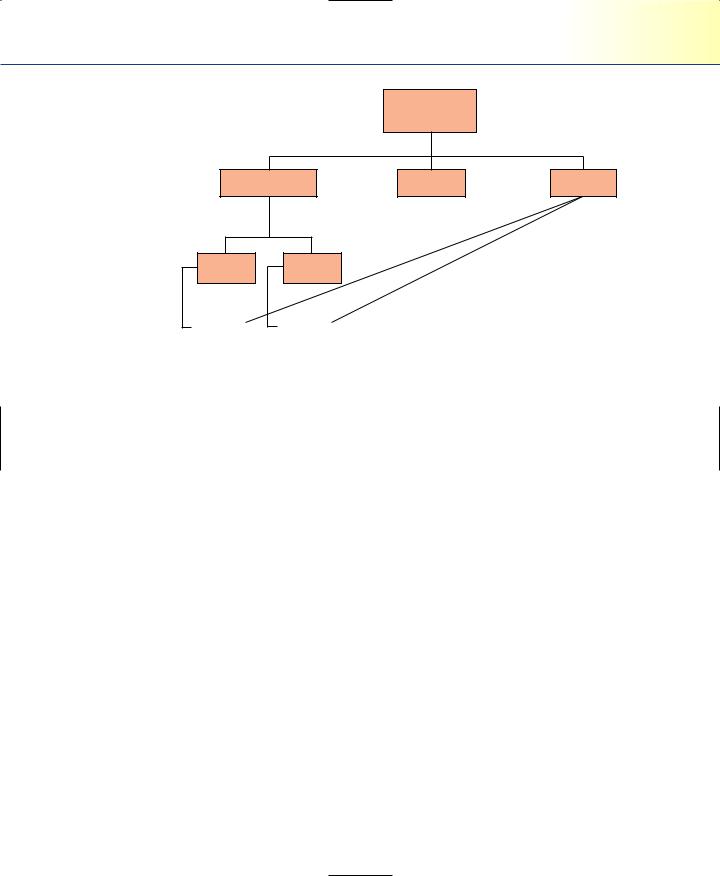
- •CONTENTS
- •PREFACE
- •Content—Benefits for Students
- •Content—Benefits for Instructors
- •Features of the Book for Students and Instructors
- •Supplementary Materials
- •Acknowledgments
- •What Is Hospitality Management?
- •The Manager’s Role in the Hospitality Industry
- •Why Study in a Hospitality Management Program?
- •Planning a Career
- •Employment as an Important Part of Your Education
- •Getting a Job
- •Employment at Graduation
- •The Outlook for Hospitality
- •Summary
- •Managing Change
- •Demand
- •Supply
- •Workforce Diversity
- •The Impact of Labor Scarcity
- •Summary
- •The Varied Field of Food Service
- •The Restaurant Business
- •The Dining Market and the Eating Market
- •Contemporary Popular-Priced Restaurants
- •Restaurants as Part of a Larger Business
- •Summary
- •Restaurant Operations
- •Making a Profit in Food Service Operations
- •Life in the Restaurant Business
- •Summary
- •Chain Restaurant Systems
- •Independent Restaurants
- •Franchised Restaurants
- •Summary
- •Competitive Conditions in Food Service
- •The Marketing Mix
- •Competition with Other Industries
- •Summary
- •Self-Operated Facilities
- •Managed-Services Companies
- •Business and Industry Food Service
- •College and University Food Service
- •Health Care Food Service
- •School and Community Food Service
- •Other Segments
- •Vending
- •Summary
- •Consumer Concerns
- •Food Service and the Environment
- •Technology
- •Summary
- •The Evolution of Lodging
- •Classifications of Hotel Properties
- •Types of Travelers
- •Anticipating Guest Needs in Providing Hospitality Service
- •Service, Service, Service
- •Summary
- •Major Functional Departments
- •The Rooms Side of the House
- •Hotel Food and Beverage Operations
- •Staff and Support Departments
- •Income and Expense Patterns and Control
- •Entry Ports and Careers
- •Summary
- •The Economics of the Hotel Business
- •Dimensions of the Hotel Investment Decision
- •Summary
- •The Conditions of Competition
- •The Marketing Mix in Lodging
- •Product in a Segmented Market
- •Price and Pricing Tactics
- •Place—and Places
- •Promotion: Marketing Communication
- •Summary
- •The Importance of Tourism
- •Travel Trends
- •The Economic Significance of Tourism
- •The United States as an International Tourist Attraction
- •Businesses Serving the Traveler
- •Noneconomic Effects of Tourism
- •Summary
- •Motives and Destinations
- •Mass-Market Tourism
- •Planned Play Environments
- •Casinos and Gaming
- •Urban Entertainment Centers
- •Temporary Attractions: Fairs and Festivals
- •Natural Environments
- •On a Lighter Note. . .
- •Summary
- •Management and Supervision
- •The Economizing Society
- •The Managerial Revolution
- •Management: A Dynamic Force in a Changing Industry
- •What Is Management?
- •Summary
- •Why Study Planning?
- •Planning in Organizations
- •Goal Setting
- •Planning in Operations
- •The Individual Worker as Planner
- •Long-Range Planning Tools
- •Summary
- •Authority: The Cement of Organizations
- •Departmentalization
- •Line and Staff
- •Issues in Organizing
- •Summary
- •Issues in Human-Resources Management
- •Fitting People to Jobs
- •Recruiting
- •Selection and Employment
- •Training
- •Retaining Employees
- •Staff Planning
- •Summary
- •The Importance of Control
- •Control and the “Cybernetic Loop”
- •Tools for Control
- •Summary
- •Leadership as Viewed by Social Scientists
- •Why People Follow
- •Leadership Theories
- •Communication
- •The Elements of Leading and Directing
- •Developing Your Own Leadership Style
- •Summary
- •A Study of Service
- •Rendering Personal Service
- •Managing the Service Transaction
- •How Companies Organize for Service
- •Summary
- •INDEX

562 |
Chapter 17 Organizing in Hospitality Management |
school lunch, in which each lunch program is located in a separate school, geo-
graphic divisions make one manager responsible for each unit.
■Customers. Some companies that operate in several different hospitality business areas divide their operations by customer type. For instance, ARAMARK groups much of its food service by customer. The Business Services division serves B&I dining, vending, and coffee services accounts. The Campus Services division services college and university food service, while the School Support Services provides services to schools. Other divisions are devoted to health care, stadiums, arenas, convention centers, conference centers, parks and resorts, and correctional facilities.
■Process. Many large hotels divide their food and beverage activities into a restaurant department, a bar department, and a banquet department because the preparation and service in these three areas can involve such different processes.
No one set of these departments represents the “best” means of division. What is important is that authority and responsibility be divided in a way that suits the particular needs of the market being served and the organization doing the work. We should note, too, that smaller organizations may not identify formal departments at all. In a small motor hotel, for example, the manager may serve as sales manager and personnel manager and take operational responsibility in the rooms or food and beverage department as well. Nevertheless, as different functions are performed, the manager— and other “double-duty” management people—realizes the need to shift gears and call different skills and styles into play. Organizational people who serve in multiple roles sometimes lament their unpredictable existences. However, they also tend to enjoy the recognition that attends their ability to get several different jobs done.
Line and Staff
LINE MANAGEMENT
Line authority is closely related to the ideas inherent in the scalar principle. Line authority passes from one operations person to another in a direct line from the top of the organization to the bottom. The rooms manager reports to the general manager. The hostess, food production manager, and banquet manager report to the food and beverage manager and, in turn, oversee subordinate supervisors and workers, as shown in Figure 17.1. A direct, unbroken line of authority runs from, say, a banquet server to the general manager. The work of line people directly affects guest service at all levels. Moreover, line management is the preponderant managerial role in the hospitality industry.

Line and Staff |
563 |
General manager
|
|
|
|
|
|
|
|
|
|
|
|
|
|
|
|
|
|
|
|
|
|
|
|
|
|
|
|
Rooms |
|
|
|
|
|
|
Food and |
|
||
|
|
department |
|
|
|
|
|
|
beverage |
|
||
|
|
|
|
|
|
|
|
|
||||
|
|
manager |
|
|
|
|
|
|
manager |
|
||
|
|
|
|
|
|
|
|
|
|
|
|
|
|
Front-office manager |
|
|
Food production manager |
||||||||
|
|
|
||||||||||
|
Executive housekeeper |
|
|
Hostess |
||||||||
|
|
|
||||||||||
|
Bell captain |
|
|
Banquet manager |
||||||||
|
|
|
||||||||||
Figure 17.1
Line organization in a hotel.
STAFF SUPPORT
Staff roles were originally limited to providing specialized assistance to line managers. Staff people, in effect, service the people who serve the guest. The staff person’s special expertise is important, but a number of related kinds of staff activities have also become common.
The Advisor. The human-resources manager and comptroller are two good examples of advisory staff positions in the hospitality industry. They have specialized knowledge about their area of work—wage-and-hour laws or accounting procedures, for instance—that the line manager they report to can and should call upon. Each of these persons also acts for the manager in his or her area of specialty; that is, these staff people not only give a manager their expert advice, but they also act for him or her and for other line people by interviewing and screening applicants or maintaining accounting records. In these acts, however, they function as representatives of the manager, and they amplify the manager’s ability in a specialized field.
Staff Service. The purchasing manager, like other staff people, renders a service to the line departments rather than directly to the guests. Similarly, the engineering department assists the line departments in maintaining the physical systems necessary to the guests’ comfort.

564Chapter 17 Organizing in Hospitality Management
The “Assistants to.” In large properties or at the corporate level, senior executives commonly designate a person as, for instance, the assistant to the manager. This person has no specific authority, but he or she assists the manager with any project requiring special attention. Persons in such jobs are not mere errand runners. The “assistant to” slot is often used to train rising young managers, and they are commonly given fairly wide-ranging (if temporary) authority for completing any project to which they are assigned. Because people in this position are usually junior to those with whom they are working, while at the same time they represent high authority, the “assistant to” position requires great tact. Its advantage is that it expands the capacity of the senior executive because it equips him or her with a trusted, able assistant who can pursue details closely and report back. Moreover, as we just suggested, it can be a valuable training slot.
The Staff as Boss. A staff person exercises authority in two kinds of situations. When the comptroller or chief engineer directs his or her subordinates in tasks, the authority exercised is clearly identical with line authority. Beyond that, as we shall see shortly, staff people are sometimes given “functional authority” over line people. Thus, the comptroller may direct the dining room cashiers (who regularly report to the hostess) in how to complete a new form. Similarly, the human-resources manager may issue a directive to all departments laying out the procedures for handling grievances. This functional authority amplifies the competence of the line, but it sometimes creates confusion.
The Staff in the Small Organization. In a small organization, the staff work may consist of part-time jobs assigned to regular employees, or it may be handled by outside specialists who provide services as needed. For instance, a 100-room motor hotel probably cannot afford a comptroller, chief engineer, or personnel manager. That property will, however, probably retain a firm of auditors to inspect its books regularly and develop an internal controls manual. Maintenance may consist of routine work done by a handyman, with the expert service of plumbers, refrigeration specialists, heating contractors, and so forth called in as needed. Finally, the general manager, his or her secretary, or some other key person probably handles the personnel work.
Issues in Organizing
L est the student consider organization a cut-and-dried matter, we should examine some of the areas of organization theory that are, more than most, unsettled. Because each of these areas also sheds light on special problems in hospitality organizations, this

Issues in Organizing |
565 |
section will serve the dual purpose of explaining theory and increasing your understanding of practice.
FUNCTIONAL STAFF AUTHORITY
We mentioned that organizations sometimes authorize staff people to give orders across the entire organization within their special field of expertise. To illustrate the value— and some of the difficulties—of this practice, consider the problems of a chain hotel organization.
Figure 17.2 illustrates the organization of this chain at the corporate level and the organization of a typical unit within the chain at the operating level. As the figure shows, one vice president is “in the line.” The vice president for operations is charged with overseeing all properties, and the general manager of each hotel reports to him or her directly.
There are five other vice presidents. These officers are specialists in the field of marketing, engineering, food and beverage, finance, and human resources; each is responsible for developing programs in his or her respective area.
Board of directors
President
Marketing |
Engineering |
Operations |
Food and |
Finance |
Human Resources |
|
beverage |
||||||
VP |
VP |
VP |
VP |
VP |
||
VP |
||||||
|
|
|
|
|
General manager
Chief engineering |
Comptroller |
|
Sales manager |
||
Human |
||
|
||
|
Resources |
|
Rooms |
Food and beverage |
|
manager |
manager |
Figure 17.2
A hotel chain organization chart.

566 |
Chapter 17 Organizing in Hospitality Management |
The work of the corporate marketing vice president, for instance, includes developing the company’s advertising program and directing its national sales office. The engineering vice president develops energy conservation measures and commands a small, highly technical staff. The vice president for food and beverage is an expert in that area of operations. He or she serves as a combination inspector, troubleshooter, and consultant in matters pertaining to food and beverage. The financial vice president oversees the company’s accounting. The human-resources officer is concerned with companywide compensation and fringe-benefit policies and monitors changes in legislation affecting employment and work practices.
Notice that each of these staff vice presidents is connected by a dotted line to a function of management at the unit level. This line indicates that each exercises staff supervision or functional staff authority over his or her special fields of work at the unit level. Now, who does the hotel’s accountant work for? Does he or she have two bosses? The answer to this question for each of these dotted-line relationships, as they are sometimes called, depends on a number of factors.
First, the relationship is essentially technical. A new financial reporting procedure may be developed, and directions for implementing it may come from the vice president. Notice, however, that it is a fairly narrow, specialized exercise of authority.
Second, the staff supervisory activity varies in intensity with both the function and the circumstance. The engineering vice president, for instance, probably interacts with the chief engineer at the property only infrequently, as, for example, when some new piece of equipment is installed or a new energy control procedure is developed. Most of the chief engineer’s work in a hotel is routine, although the work of the vice president is almost entirely specialized and technical. On the other hand, if a major renovation of the hotel is undertaken, the engineering vice president would work much more closely with the property.
The human-resources vice president does not tell the local human resources manager whom to interview or hire. That is the work of the line managers at the property. On the other hand, the vice president will take an interest in the hiring process as it relates to complying with law, as in fair-employment practices.
The possibilities of mixed loyalties on the general manager’s staff and of clashes between general manager and staff vice presidents are remote, but clearly these relationships call for tact. The disadvantages that accompany these blurred lines of authority are more than offset by the top-quality expertise made available. The hospitality industry is becoming too complex a business to do without such an expert staff.
One area in which staff supervision has proved uncommonly difficult is food and beverage. This area really involves a line function; therefore, a number of companies have eliminated staff supervision in this area, leaving it entirely in the hands of the general manager.

Issues in Organizing |
567 |
Independent operators avail themselves of various kinds of expert advice. We noted some of them earlier: an accountant, an attorney, specialized engineering people. The manager of the operation must often achieve the necessary expertise to act as a staff specialist in some areas, particularly marketing. Many a general manager has been heard to remark, “I’m wearing my sales manager’s hat today.” In fact, hotel general managers often join the Hospitality Sales and Marketing Association International specifically for this reason.
INCREASING THE SPAN OF CONTROL: EMPOWERING MANAGERS
Only a generation ago, a leading French management writer, Jean Jacques ServanSchreiber, pointed out that one of the major factors in the success of American companies was their more fully developed organization structure.2 Companies in the United States had more supervisors and more levels of supervision, and as a result, they had better control over quality. Now this pattern is reversing itself and the “flat organization” (i.e., one without a hierarchical, many-tiered management structure) is becoming the norm. Many multiunit companies are reducing dramatically the number of levels of field supervision, with the result that the remaining supervisors oversee more units.
Taco Bell and Pizza Hut have been prominently associated with restructuring their organization to eliminate intermediate layers of management. This increases the responsibilities of the remaining managers. The span of control for field supervisors, such as area managers at Taco Bell, went from one area manager for every “five-plus stores to one for every 20-plus stores.”3 Pizza Hut did away with one whole level of management, the district managers. District managers used to supervise five to seven stores. Now, area managers supervise 11 or more stores.4 The difference between the span of control at these two Yum! Brands subsidiaries is probably accounted for, in large part, by the greater complexity of the Pizza Hut operation.
The reduction in middle managers and the increase in span of control has more than one effect. It cuts out an expensive layer of managers, complete with salaries, fringe benefits, expenses, clerical support, and office space. More important, perhaps, the role of the multiunit manager changes.
The remaining area managers now have about twice as many stores to oversee. They obviously can’t spend as much time with each store. That means the individual store manager has more responsibility for her or his own operation. The kind of supervision, moreover, that an area manager can give 20 or 12 stores is different from that which one district manager used to give 5 or 6 stores. There is much less time for detail and personal involvement in the operation. We might expect the role to be more that of a consultant than of a boss, and the nature of the interaction to be more that of one who gives expert advice than of one who gives detailed orders. This makes the

568Chapter 17 Organizing in Hospitality Management
store manager much more responsible for the success or failure of his or her own unit. No doubt, that sometimes feels like sink-or-swim.
The evidence to date suggests that increasing the span of control works. We see it being done by more and more companies. Domino’s eliminated a number of middlemanagement positions by consolidating eight regional offices into five. The lodging company Promus (since broken up) put it this way:
As we reduce layers of management, we improve communications and allow each employee to expand his or her responsibilities. This is our commitment to empow- erment—allowing our employees to grow and assume more responsibility to provide excellent service to every customer every time. . . .
Empowerment requires an environment of teamwork and cooperation with minimal layers of supervision and maximum individual responsibility.5
COMMITTEES
Complex organizations that make decisions involving several departments, or disciplines, need methods for communicating and involving different kinds of specialized expertise. Although “management by committee” is really a contradiction in terms, committees often serve as management devices in health care, education, and all kinds of governmental activities, such as congregate feeding and school lunch programs. Although the role of committees is not so prominent at the unit operating level in the private sector, many properties find committees useful in a number of areas, particularly in energy conservation and environmental management and recycling programs. Most companies make extensive use of committees at the headquarters level.
Committees allow a number of different interests to gain representation. In health care, the dietary department often prepares food that is delivered to the nursing-care staff, which, in turn, delivers the food to the patients. The food may be purchased for the dietary department by a separate purchasing office, which may also receive the deliveries and handle bulk product storage. The staff cafeteria is sometimes intended as a fringe benefit to employees, providing subsidized meals to the staff below cost. This makes the dietary department important to the personnel officer, just as the need for cafeteria and other accounting procedures makes the dietary department important to the accounting office. The nature of the dietary department’s work might well require an advisory committee, to help it react to proposed operating or policy changes.
Such a committee offers all the advantages usually advanced for committees: It helps coordinate plans and transfer information. Committee membership by junior management provides an opportunity for management development as the junior members come to learn how the organization functions. Occasionally, the committee

Issues in Organizing |
569 |
also builds morale: When everyone is consulted, no one is offended, or so the argument goes.
The disadvantages of committees can offset their advantages to some degree. Committees tend to consume a great deal of time. A one-hour meeting of six people consumes six labor hours. Moreover, committees often avoid action rather than take it, and they can be used to avoid or shift responsibility for unpopular or risky decisions. In addition, because committees are supposed to give a hearing to many views, they often encourage compromise.
The case for consultation in the hospital dietary department does not necessarily call for a committee. A committee will regularize consultation, but the same consultation could take place informally among the interested parties. This approach might take a little more time for the person seeking the consultation, but it would almost certainly take less time for all the participants.
Committees are unquestionably useful where the purpose served warrants their use. For example, in energy and recycling management, many hospitality organizations find the committee approach unusually effective in communicating technical information across the organization and in funneling practical suggestions to management. In these cases, committees also serve as a motivational tool by allowing all participants to be involved.
BUREAUCRACY
Bureaucracy is a bad word to most Americans. It is curious, therefore, to realize that Max Weber, the German sociologist who invented the term, developed his theory of bureaucracy as an ideal type of large organization and an ideal way of how it should be run. The following characteristics are those that Weber identified as part of a large hierarchical organization:
1.The organization’s work is embodied in statements of fixed official duties.
2.Decisions are governed by abstract, rational rules that are the only proper basis for decision.
3.The bureaucratic official avoids emotionalism and is impersonal.
4.Technical qualification in the appropriate field is the basis for entry and advancement in a bureaucracy.
Weber’s model of bureaucracy seeks the most efficient solution to problems on strictly impersonal, rational grounds. Bureaucracy is a means of avoiding the arbitrary exercise of power as in an absolute monarchy, in which people exercise power because of their relationship to the monarch or some other person in power. It also seeks to

570Chapter 17 Organizing in Hospitality Management
avoid the problem of political organizations in which the “in” clique holds sway over everyone. In sum, then, it seeks to replace personal relationships—with their possibility for favor and lack of fairness—with an impersonal, rational, efficient organization.
As large organizations have come to play a more and more important role in our society, we have discovered that bureaucratic politics (a notion that Weber would have abhorred) has become a problem and that bureaucrats can, in fact, be arbitrary and unfair, bending rules to their own purposes. Bureaucracies, moreover, can seek “efficient” solutions in ways that are wildly wasteful.6
Weber’s contribution, however, remains. He asserted (and subsequent management scholars have confirmed) that large organizations have special problems. The special organizational rules along the lines that Weber suggested, although far from perfect, clearly constitute a useful starting point for solutions to organizational design problems in an increasingly complicated society.
AD HOCRACY
In his book Future Shock, Alvin Toffler pointed to a significant development in organizations that began in the aerospace industry and other scienceand engineering-re- lated activities. Toffler dubbed this new approach to management “ad hocracy.” The term is derived from the Latin phrase ad hoc, meaning “to this.” The idea is that of an organization responding forcefully to particular situations in an environment that constantly changes. In these situations, the work to be done, rather than a traditional organizational structure, dictates who is in charge. The structure can best be described as a team with changeable captains. If the problem to be solved involves engineering, the team leader will be an engineer with the skills appropriate to the current need. If the problem lies in another area, the person with the necessary abilities will take the reins.
Although most hospitality organizations follow the traditional line or line-and-staff organization, operations whose problems resemble those of the aerospace industry are emerging, especially among the new, large resort and casino operations.
Casino Resort Hotels. A large casino resort hotel is actually involved in five different businesses in a big way (and a few other businesses less closely connected to its operating format and organizational structure). First, casino resort hotels are among the world’s largest hotels. Second, they are among the world’s largest gambling centers. Third, many are a major factor in the convention business in North America, with numerous meeting and banquet rooms ranging in capacity from under 100 to thousands. Fourth, they are large centers for entertaining and dining, boasting numerous restaurants, each with a distinctive menu and atmosphere. Finally, they usually feature large and extravagant stage shows.

Issues in Organizing |
571 |
Operating these businesses for one common clientele would be challenge enough. The hotel’s situation is complicated, however, by the fact that it caters to three different markets: the casual visitor, who comes alone or with family for a Las Vegas vacation; the convention guest; and the junketeer.
These hotels serve the first market, the traditional class of guest, with the traditional departments that operate according to an organization structure similar to that of any other hotel. The other two kinds of guests, however, present special cases, because each has been attracted by a specific marketing activity in a highly competitive area.
The national convention market receives the attention of literally hundreds of top hotel sales organizations. As a result, when a convention is sold, the hotel’s marketing department must follow up on the service. If, for instance, the sales department has promised a special registration procedure on arrival or has agreed to some special service for a banquet, sales must have the means of seeing to it that the special agreement is met. Moreover, if a problem develops for the convention group, the group’s contact person will probably want to turn for help to the sales representative with whom he or she first dealt. That sales representative needs the organizational means to solve problems.
Junket guests are gamblers (with good credit ratings) who visit Las Vegas as guests of the hotel with all expenses paid, often including transportation both ways. Although some of these visitors win at the gambling tables, the perfectly legitimate casino percentages favor the house more than enough to cover the cost of visits over the long run. Many of Las Vegas’s major hotels solicit junket business. This solicitation is principally directed by the marketing department. Once again, when junket guests get to the hotel, these high rollers must receive excellent treatment so that the marketing department’s efforts to secure return visits remain fruitful.
To solve the problem of these special markets, many Las Vegas hotels have evolved an unusual organization structure. In the typical hotel, a simple (oversimplified) organization structure might look like the one in Figure 17.3. The marketing department sells, and the operating departments service the sale. The convention guest might have some contact with the sales representative, but this contact is probably just either a quick, friendly visit or some limited liaison with the operating department.
Many casino hotels, however, have built a somewhat different structure, as illustrated in Figure 17.4. When an individual guest arrives, the organization functions much as it does in traditional hotels. When a convention arrives, however, the marketing department stations a representative at the front desk during registration. This representative has the authority to intervene and settle any problems related to servicing the sale. Similarly, a representative of the marketing department is present at convention banquets, working right along with the food and beverage department’s supervisors again to guarantee the service sold by the marketing department. A similar, though less formalized, system operates for junket guests.

Large casino hotels resorts have developed flexible organizational structures to respond to a complex mix of customers. (Courtesy of New York, New York Hotel, Las Vegas.)
General manager
Marketing
Rooms
Food and
beverage
Activities |
Activities |
Figure 17.3
Traditional hotel organization.
Large casino hotels resorts have developed flexible organizational structures to respond to a complex mix of customers. (Courtesy of New York, New York Hotel, Las Vegas.)

Issues in Organizing |
573 |
Executive vice president
General manager |
Casino |
Marketing |
Rooms
Food and beverage
Activities Activities
Figure 17.4
Ad hocracy in a casino resort.
For this reason, we have to draw solid lines in Figure 17.4, indicating authority between the marketing department and the operating department activities.
Although confusion undoubtedly arises from time to time, this organization functions smoothly. People who work in complex organizations learn to live with relationships that are more complex. Casino hotels must determine authority by the task at hand.7
Walt Disney World. Walt Disney World (WDW) is another highly complex resort organization comprising several distinct businesses, including a theme park, food service, hotel operations, entertainment districts, outdoor camping, and sports. The problems at WDW are twofold. First, the park is constantly changing and growing, and will be for many years to come. This problem of growth and change is complicated by dramatic swings in volume that see the workforce at WDW more than double during the summer’s peak season.
During a visit to WDW, we were impressed by one small but interesting fact: The food service organization chart was drawn on a large metallic blackboard. Departments and organizational units were connected by chalk lines, and all the names on the board were on small magnetized plaques that could easily be moved around on the board. Conversation confirmed the impression suggested by the board: The organization structure changed so fast at WDW that the only way management could keep up with it was to use a medium on which changes could be made often and easily.
We do not intend to imply that blackboards are better than paper for organization charts; rather, the point is that dynamic organization forms are increasingly required in growing, changing, complex hospitality firms.
